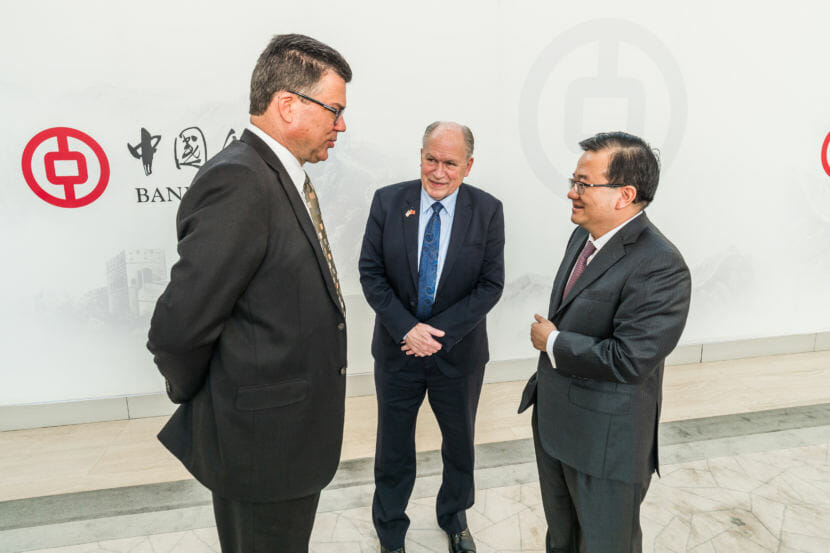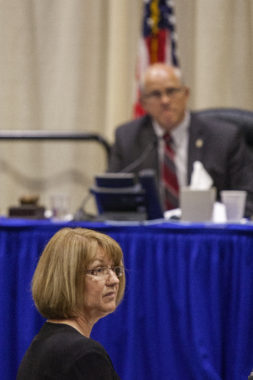
Over the last several weeks, there have been several announcements from the state’s gas line corporation.
The Alaska Gasline Development Corporation spent at least $2 million marketing Alaska’s megaproject this year. And so far, it has signed agreements to explore the project with potential partners and possible customers in China, South Korea, Japan and Vietnam.
It has spent another $1 million on promotional handouts, trade shows and communications.
But, back in Alaska lawmakers are still pushing for more. They’re asking questions about the money being spent and what may come back in to the state.
The state’s gasline corporation has a transparency problem. It’s either being forced to give up too much information, hurting its chances of being competitive in the global liquefied natural gas market. Or, the corporation with the highest paid state employee at its helm, isn’t disclosing enough about what it’s doing with the state’s money.
This isn’t a new argument. The 40-year history of the Alaska North Slope gas project has become something of a political football, never making it into the end zone. But, it’s communication issue is relatively new since the state got involved as a project partner several years ago.
It came up during a Dec. 7 board of directors meeting.
“You know, it’s interesting to me that you believe, I believe, the board believes, the governor believes, the president believes that this project is real,” said board member Marc Luiken. “And really, China. You know, entities in China, entities in Korea, Japan, Vietnam, believe this project is real.”
He said in Alaska, it seems that people don’t believe the project is real. He said that calls for a deliberate, aggressive communication strategy.
“The commercial effort, the regulatory effort, the engineering effort, are all very important also,” Luiken said. “But we need to help Alaskans believe this project is real.”
But transparency is a fundamental tension of a public corporation. It’s supposed to act like a business. That means some things have to be secret. But, it’s spending the state’s money. That means that some things can’t be secret.
Calls for transparency and more information have gotten louder since the state took over the project from North Slope oil and gas producers a year ago. They’ve gotten so loud that last year, the legislator who helped to create the state corporation, launched an audit of its spending.
Sen. Anna MacKinnon, R-Eagle River, chairs the Senate Finance committee. She said her committee has been asking the same questions for a long time. How much will the state’s gas be worth? And, after all of that debt is paid, what will be left for Alaskans?
So far?
“We are not getting the information that we’ve requested,” MacKinnon said. “You certainly don’t want to show your hand in the cost scenario when you’re negotiating with someone. These are sensitive issues. But the finance committee is going to need to see those numbers.”

What’s left over once the owners of the gas and the project financiers take their cut — that’s an important number for lawmakers. It helps them decide whether the pipeline and LNG export project is a good deal for the state.
The state’s share of the profit happens to be one of the few things corporation can play with to cut the price of gas to Asian buyers. Cutting the state’s share lowers the cost to LNG customers and makes it more competitive in a tough market.
MacKinnon said, she wants to see the bottom line.
Putting the state’s money on the line in a multi-billion commercial project, that’s a hard choice for a lot of lawmakers. It’s unfamiliar territory. It’s relatively easy to the see the benefit of putting state money into a highway or a school. Pumping millions, maybe billions, in to a giant risky gasline isn’t as clear cut.
“I want to see that there’s a profitable project here,” MacKinnon said. “And I need some guarantee — from someone that the finance committee believes — that this project can economically benefit the people of Alaska.”
That sentiment of wanting more detailed financial information from the gasline corporation, it’s not universal.
Rep. Geran Tarr, D-Anchorage, said some of the information lawmakers are asking for, it just isn’t possible to know until the final contracts are drawn up.
“At some point we do have to trust that these are professionals that know how to do the day to day management,” Tarr said. “Because really, the state legislature cannot micromanage this project, right?”
That’s not to say that Tarr has no questions for the corporation. But, she’s thinking about ways she can get them answered that won’t require divulging them to the public.
“I’m considering signing a confidentiality agreement so that I can see more of the paperwork,” she said.
Other lawmakers have done it. According to the corporation, Senate Resources chair Cathy Giessel, R-Anchorage, and her staff member Akis Gialopsos have signed them. So has Bruce Tangeman, a staff member for Sen. Pete Kelly, R-Fairbanks. So far, none of them have requested access to any further information, according to an email from the Governor’s office.
But, it’s not likely that the tension over what should be communicated — and what shouldn’t — is going to ease up anytime soon.
That breakdown in communication, it came up again this week.
This past Monday evening, about a dozen lawmakers legislators gathered in person and by phone at a three-hour House Resources Committee meeting in Anchorage, to hear an update from the state corporation. At about 8 p.m., two hours into the meeting, Rep. Lance Pruitt, R-East Anchorage, asked a question.
Not about finances or transparency. This one was about basic project management and construction cost risk.
“What happened to FEED?” Pruitt said.
That’s Front End Engineering and Design. It’s basically all of the homework that has to get done before you start building a project. It’s the final blueprint and every construction detail, schedule and cost estimate. The more time you spend on it, the fewer surprises there are on the test. In this case, Alaska’s final exam grade is based on the risk of construction delays cost overruns.
Before the state took over, this was supposed to be a two-year process that could cost more than $1 billion to get through. At the end of it, project partners would look at the data and make a final go or no go decision.
But, when the state took over, the model changed. Corporation President Keith Meyer said now, instead of doing the engineering and design work in-house they’re planning to wrap it all into the construction bid. Basically, the state will get a final investment decision from its partners. Then it’ll ask for what it wants built, the contractor will engineer the job and put it together.
That didn’t sit well with Pruitt.
“This is a huge, huge change. I mean, I understand what you’re indicating,” Pruitt said. “But, the turnkey might work for an LNG plant. But, we’re talking about an 800 mile pipeline. You can’t turnkey that thing.”
Meyer said there are pros and cons to both models. But, either way, Pruitt said that change should have been communicated clearly.
“We are the decision-makers ultimately. We’re the ones that are going to commit the billions of dollars that are necessary. They’ve got to communicate to us,” he said in a later interview.
So far, all of the state corporation’s agreements have been non-binding. None of the potential partners or customers are spending money to move the project forward. And that leaves lawmakers to decide if they want to put more money into the effort.
But so far, many lawmakers have said they aren’t sure the project is far enough along to merit getting any more money.
